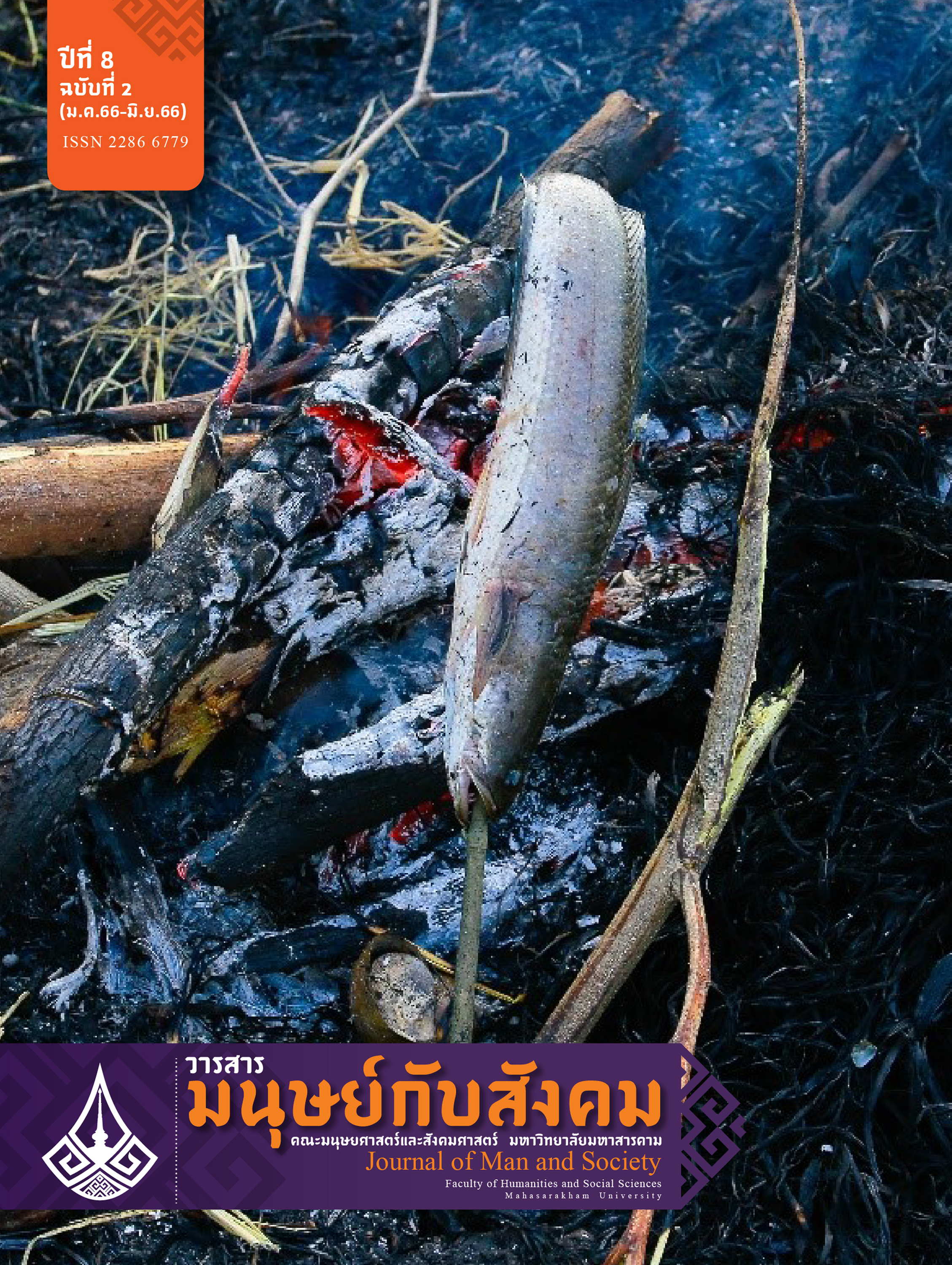A Study of Lua Ethnic Group Legends in Ximeng District, Pu’er City, Yunnan Province, People’s Republic of China
Main Article Content
Abstract
This study aims to select and translate legends of the Lua ethnic group in Ximeng District, Pu’er City, Yunnan Province, People’s Republic of China. The research method is the selection and translation of Lua legends in Si Gang Li. The study found that Si Gang Li comprises 26 chapters. The researcher found six legends: 1) the Creation of the World, the study found that Lua people worship MoWei as the supreme god, and 2) the Origin of Si Gang Li. The study found that Lua’s ancestors came from Si Gang Li Cave, which is considered Lua’s origin and grassroots; 3) the Flood, the study found that the Wa people experienced two floods.; 4) the Creation of houses, clothing, and agriculture. The study also found that the Dawa god distributed water to various ethnic groups and divided the work among his eight children, and the AnMuLuo god taught Lua people how to build houses; 5) the Worship of Ancestors, the study found that the AnMuGuai god worshipped his mother’s spirit and this originated the tradition of ancestor worship; and 6) the Wooden Drum, the study found that Lua people used MoWei drum as a tool to communicate with gods. All these six legends talk about the Lua people's background, culture, beliefs, tradition, and way of life.
Article Details

This work is licensed under a Creative Commons Attribution-NonCommercial-NoDerivatives 4.0 International License.
เนื้อหาและข้อมูลที่ตีพิมพ์ลงในวารสารมนุษย์กับสังคม ถือเป็นข้อคิดเห็นและความรับผิดชอบโดยตรงของผู้เขียนซึ่งกองบรรณาธิการวารสารไม่จำเป็นต้องเห็นด้วยหรือร่วมรับผิดชอบใดๆ
บทความ ข้อมูล เนื้อหา รูปภาพ ฯลฯ ที่ได้รับการตีพิมพ์ในวารสารมนุษย์กับสังคม ถือเป็นลิขสิทธิ์ของวารสาร หากบุคคลหรือหน่วยงานใดต้องการนำทั้งหมดหรือส่วนหนึ่งส่วนใดไปเผยแพร่ต่อต้องอ้างอิงวาสาร
References
ฉวีวรรณ ประจวบเหมาะ และคณะ. (2555). ปริศนาวงศาคณาญาติ “ลัวะ”. กรุงเทพฯ: ศูนย์มานุษยวิทยาสิรินธร (องค์การมหาชน).
ชลธิรา สัตยาวัฒนา. (2530). ลัวะเมืองน่าน. กรุงเทพฯ: สำนักพิมพ์เมืองโบราณ อมรินทร์พริ้นติ้งจำกัด.
ฐนวิชณ์ ไกรเพิ่ม. (2559). ทฤษฎีความหมายกับการแปลบริบททางวัฒนธรรมในวรรณกรรมแปลเรื่อง เมนูคนบาป จานโปรดสําหรับคนใจร้าย ของ ฌอง เติลเล่. วารสารมนุษยศาสตร์และสังคมศาสตร์ มหาวิทยาลัยรังสิต, 12(21), 49-66.
รัชนี กาวิ. (2558). นิทาน ตำนาน ภูมินามและประวัติศาสตร์: บทบาทหน้าที่ คุณค่าและอัตลักษณ์ของชุมชนท่าผาปุ้ม อำเภอแม่ลาน้อย จังหวัดแม่ฮ่องสอน. [วิทยานิพนธ์อักษรศาสตรมหาบัณฑิต สาขาวิชาภาษาไทย, มหาวิทยาลัยราชภัฏเชียงใหม่].
ศิราพร ณ ถลาง. (2539). การวิเคราะตำนานสร้างโลกของคนไท. [วิทยานิพนธ์อักษรศาสตรมหาบัณฑิต สาขาวิชาศิลปศาสตร์, มหาวิทยาลัยสุโขทัยธรรมาธิราช].
อาสา คำภา. (2555). ปู่แสะย่าแสะ กับประเพณีเลี้ยงผีเมืองเชียงใหม่. วารสารสังคมศาสตร์สุรนารี, 6(2): 99-122.
อรรถรัตน์ ฆะสันต์. (2553). คติความเชื่อและภูมิปัญญาซึ่งสัมพันธ์กับการตั้งถิ่นฐานผังหมู่บ้านและบ้านเรือนของชุมชนชาติพันธุ์ลัวะ ในประเทศไทย. [ปริญญานิพนธ์การศึกษามหาบัณฑิต สาขาวิชาสถาปัตยกรรมพื้นถิ่น, มหาวิทยาลัยศิลปากร].
อภิสิทธิ์ สัมยศ. (2550). วิถีชีวิตของชุมชนลัวะกับการพัฒนา: กรณีศึกษา บ้านสาม ตำบลห้วยห้อม อำเภอแม่ลาน้อย จังหวัดแม่ฮ่องสอน. [ปริญญาวิทยาศาสตรมหาบัณฑิต สาขาวิชาการพัฒนาภูมิสังคมอย่างยั่งยืน, มหาวิทยาลัยแม่โจ้].
อรุณรัตน์ วิเชียรเขียว. (2543). ลัวะ (ละว้า): ศึกษาจากเอกสารคัมภีร์ใบลานและจารึก. เชียงใหม่: สถาบันราชภัฏเชียงใหม่.
เอื้อมพร จรนามล. (2556). โลกทัศน์ที่ปรากฏในนิทานพื้นบ้านไทลื้อ อำเภอเชียงคำ จังหวัดพะเยา. วารสารมนุษยศาสตร์และสังคมศาสตร์ มหาวิทยาลัยพะเยา, 1(3), 28-38.
โอยู แมน และ นันท์ชญา มหาขันธ์. (2561). ตำนานสร้างโลกของกลุ่มชนชาติไท-จ้วง: โลกทัศน์ ความเชื่อและ พิธีกรรม. วารสารวิชาการมนุษยศาสตร์และสังคมศาสตร์, 26(52): 304-328.
毕登程、隋嘎. (2009). 司岗里. 云南: 云南人民出版社.
陈静、唐曹. (2006). 葫芦与人类起源神话——云南少数民族葫芦崇拜的文化解读. 湖北社会科学, 9(1): 115-116.
邱锷锋. (1957). 佤族社会历史调查. 云南: 云南人民出版社.
马少展、宁成春. (1981). 中国少数民族. 北京: 人民出版社.
裴晓睿. (2014). 新汉泰词典. 广西: 广西教育出版社.


